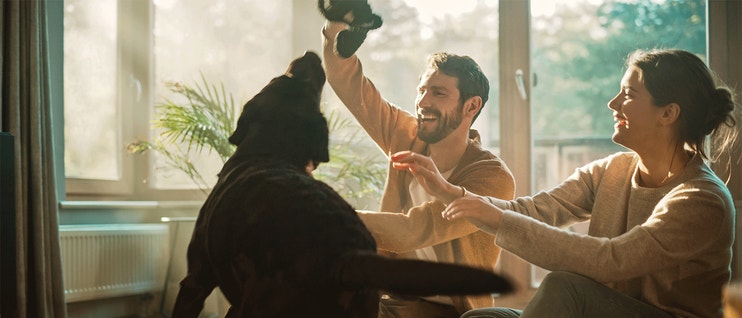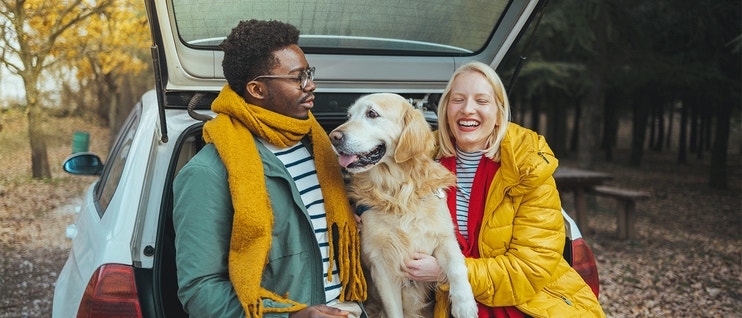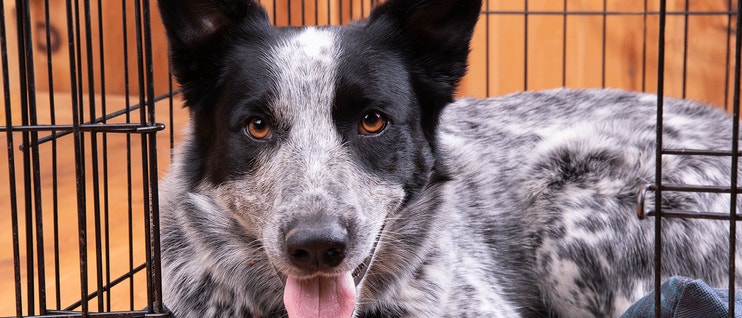
The Dog Adoption Prep Checklist with Adopt a Pet
The dog adoption checklist: Everything new pet parents need to know
Welcoming a furry friend into your life is an exciting event, but providing proper care for your newly adopted dog involves more than just affection. We’ve compiled a dog adoption checklist to ensure you're well-equipped with everything necessary for a fulfilling life as a rescue dog parent. From enrolling with a vet to coordinating training sessions, our comprehensive Dog Adoption Prep Checklist with Adopt a Pet includes all of the essential dog supplies you need to make your preparation smooth and stress free .
Once your furry friend arrives, you can dedicate your time to developing a strong bond with them, secure in the knowledge that all necessary arrangements have been made and all the essential goods have been purchased. Let’s get into it…
What to do before you pick up your new dog or puppy
To help ensure a smooth transition for your newly adopted dog, here are some essential things to consider:
Locate a vet
One of the first things you should do is locate a vet. Opt for a nearby clinic to avoid long car trips in case of emergencies. It's also wise to inquire about any documentation they might need to see, what to bring to your first visit, and their out-of-hours care or whether another clinic covers this for them.
Check if your dog is microchipped
Ensure that your newly adopted dog or puppy is microchipped, as this will give you the best chance of being reunited with your dog if they go missing. If you're adopting your pet from a shelter or rescue, they may take care of the microchipping process and provide you with the necessary database contact details. After bringing your new canine companion home, promptly update the database with your information.
Plan for veterinary costs
It's always good to have a financial safety net for vet bills, emergencies, regular checkups, and unexpected health issues. This way, you can quickly get your dog the care they need without stressing about costs, making sure they stay happy and healthy. One way to do this is by getting pet insurance for your adopted dog. When you're checking out insurance options, just take some time to understand what each policy covers - ensuring it’s sufficient/relevant for your dog's needs and age.
Alternatively, you could set up a separate fund/account for medical care, or check with your vet to see if they offer a Wellness Plan.
Craft a training plan
Training your new dog is a great way for you and your dog to bond. Fundamentals like "sit," "stay," and "down" are not only great tricks, but they can be useful for vet trips or having visitors over. Make sure to identify what motivates your dog for training, such as treats or toys. You can put together a training plan yourself, work with a local trainer by attending group classes, or opt for one on one lessons for you and your dog.
Pup-proof your place
Puppies and even older dogs can be quite curious and may pose a risk to themselves and your home. Take measures to dog-proof your living space, considering potential hazards and making necessary adjustments. Specific advice on this topic will be discussed in the following section.
Learn more about how to prepare for adopting a dog by downloading the full Dog Adoption Prep Checklist with Adopt a Pet.

Setting up a Dog-Proofing Your Home
While you can’t change how quickly your dog settles in, you can start by pup-proofing your home to make them feel a bit safer and more comfortable. Move objects that they can chew and ensure they can't reach dangerous items such as electrical cords or toxic substances.
Once that’s done, it’s time to set up your dog’s eating, sleeping and resting areas. Some dogs may feel more comfortable eating where they sleep/rest, especially in the first few days as they get used to their surroundings. Other dogs may prefer separate areas for eating and sleeping. If you’re getting a puppy, it’s helpful if one of their resting areas is close to an external door. This makes housetraining easier.
The rest area, including a cozy den and/or crate, should be in a quiet and safe space for your dog to feel comfortable. This should be away from external doors, busy areas and the direct sight of a window. Explain to family and friends that when your dog is there, they shouldn't be disturbed. If there are specific areas of your house you’d like to block off, consider installing baby gates.
If you have a garden that your dog can access, you’ll need to make that dog-safe too. Remove toxic plants (such as: Chrysanthemums, Foxglove, Lilies and Tulips) and ensure that sharp tools and harmful substances are locked safely away.
Once your dog is home, consider the 3-3-3 rule:
- In the initial 3 days, your dog may feel overwhelmed; allow them to explore at their own pace and gradually introduce them to different areas for a sense of security.
- By the end of 3 weeks, your dog will likely settle in, so establish consistent routines for walks, meals, and playtime. Bond through positive experiences to build trust.
- After 3 months, your dog should feel secure in their new home. Reinforce routines and boundaries, addressing behavioral changes with patience and positive reinforcement.
What to buy for the first month with your new dog or puppy
From bedding to toys, these items and supplies should get you through the first few weeks with your new dog.
For the house
- Washable beds and bedding, large enough for your dog to sprawl out on and get comfortable. It’s better to have more than one resting area if you have the space.
- A crate if you’re planning to crate train your pup, to be used as a cozy den area.
- Food and water bowls, including spares.
- Food that your dog is familiar with – ask the shelter or rescue what your dog has been eating. If you need or want to switch their dog food once they are settled, your vet can tell you more about transitioning your dog to a different food and about diet in general.
- Treats for training, appropriate for your dog’s size and age.
- Feeding enrichment toys such as food puzzles and slow feeders. Any toys need to be robust and the right size for your dog so they can’t be swallowed.
- Toys for keeping your dog entertained, for play and to help teething puppies. Ask the shelter or rescue if your dog had any favorite toys while in their care.
- House training pads for smaller dogs
- Dog-safe house cleaning sprays/wipes in case your dog has an accident in the house.
For grooming
- First, evaluate your dog's grooming needs, and determine if that is something you want to do at home or whether you would feel more comfortable finding a local groomer.
- A suitable brush for your dog's coat type to remove tangles and mats.
- Dental care products such as a dog toothbrush and specially formulated doggy toothpaste for maintaining your pooch’s oral health. PEDIGREE® DENTASTIX™ are also a great option for cleaning your dog's teeth and reducing plaque buildup.<
- Grooming scissors, for trimming hair around the eyes, ears, and paws.
- how to trim your dog's nails.
- Select a gentle shampoo specifically formulated to give your new dog a mild and effective scrub.
Discover more shopping list suggestions by downloading the full Dog Adoption Prep Checklist with Adopt a Pet.

Prepare for outside experiences and housetraining
If you adopted a puppy, talk to your veterinarian about your puppy’s health and vaccination status before exposing them to public places. Create positive associations with outdoor experiences through play, treats, and praise. You should get your puppy used to a short leash indoors for positive associations before going outside. Prioritize your puppy's well-being and consult your vet for specific guidance based on factors like breed, age, and health.
For adult dogs, a gradual introduction to their new environment is beneficial. Start with shorter walks along the same route during your initial outings, progressively incorporating new and longer walks over time.
When it comes to housetraining, here are some tips to seamlessly integrate into your routine:
- Supervise and Connect: Keep a close eye on your dog indoors by utilizing a crate or confining your dog to one room.
- Choose a Potty Spot: Designate a preferred outdoor spot for bathroom breaks. Opt for surfaces like grass or gravel.
- Establish a Daily Routine: Set a consistent schedule for sleep, meals, and playtime. Take your dog to the outdoor spot regularly, especially after waking and meals. Gradually increase the time between visits as your dog learns.
- Introduce a Cue: Use a friendly cue like "Let's Go Potty." Say it just before your dog does their business.
- Celebrate Success: Celebrate outdoor success with lots of praise and treats.
Remember, each dog is unique, so stay patient, positive, and enjoy building a strong bond with your furry friend throughout the process.
You’re all set to pick up your pooch
Getting a puppy or dog is an exciting time. But a big commitment means there’s so much to think about in those first few days and weeks, so it may seem difficult to know where to start. Hopefully, our Dog Adoption Prep Checklist with Adopt a Pet should take the guesswork out of preparing, so you can focus on bonding with your new friend. Remember, building a solid bond with your furry friend starts from the moment you pick them up. Focus on bonding with your adopted dog and you're off to a beautiful friendship that will change your life forever. We’ve got you.
Ready to find your new furry friend? Discover adoptable dogs in your area on Adopt a Pet.




